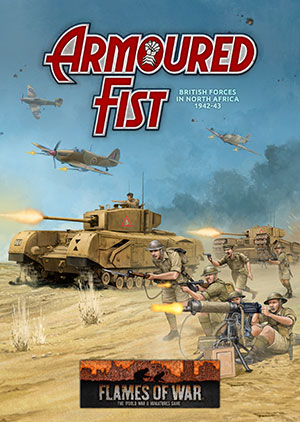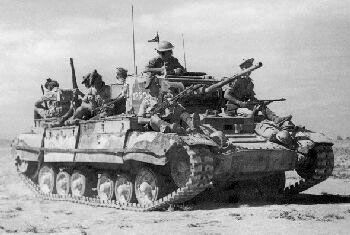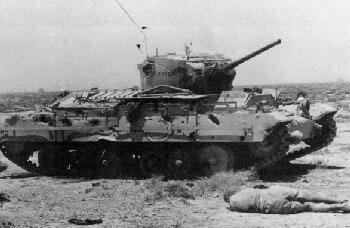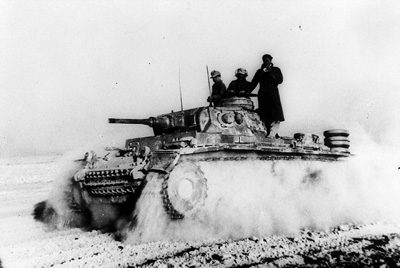|
|
 |
|
|
23rd AB at Ruweisat Ridge
 |
40th (The Kings) RTR
23rd Armoured Brigade, Ruweisat Ridge, 22 July 1942
In July 1942, Rommel’s desert offensive had been halted at El Alamein, just short of Alexandria. The British 8th Army was hanging on by the skin of its teeth, its divisions battered and its armour almost gone. Before they could push the German Afrika Korps back out of Egypt, the 8th Army needed reinforcements, and lots of them.
Help was at hand. The 8th Armoured Division had been shipped round the Cape from Britain earlier in the year and finally arrived in Egypt in July. The situation was so desperate that the first arrivals, the 23rd Armoured Brigade, were sent into battle as soon as they arrived, not waiting for the rest of the division.
The Afrika Korps held the vital Ruweisat ridge driving a wedge deep into the British position. If Egypt was to be held, the ridge must be recaptured. A previous attack by the 2nd New Zealand and 4th Indian Divisions had failed with heavy losses when the 1st Armoured Division failed to protect them from marauding German armour.
|
|
Another attack was planned and this time the 23rd Armoured Brigade would be supporting. It was hoped that these fresh troops would be more aggressive than the overly cautious veterans of 1st Armoured Division. All three of the Brigade’s armoured regiments would be involved. 40th (The Kings) RTR and 46th (Liverpool Welsh) RTR would support the New Zealanders, while 50th RTR supported the 9th Australian Division attacking the other end of the ridge.
At dawn the New Zealand infantry were on their objectives. Rommel had launched his counterattack and things were looking grim. The sappers hadn’t cleared gaps in the anti-tank minefields between the tanks and the infantry, and the 23rd Armoured Brigade having finally seen the ground they were supposed to cross were questioning the wisdom of the attack.
|
 |
 |
The orders came through; the attack would take place as planned. The Valentine tanks of 40th and 46th RTR would charge to the rescue at top speed!
Ruweisat Ridge, 8am, 23rd July
Kicking up clouds of dust, the 104 Valentine tanks of 40th RTR and 46th RTR charges forward at 15 miles per hour, heading north towards the New Zealand positions a mile and a half away. Within minutes they ran onto the minefields, losing two dozen tanks. Still they charged on, C Squadron, 40th RTR in the lead with the three tanks of Lieutenant Lewis Wiard’s 12 Troop taking point.
|
|
Soon they came under fire. The tanks and guns of both 15th and 21st Panzer Divisions surrounded them on three sides. Seeing only the guns ahead, the green crews valiantly sought to close the range and engage. Lieutenant Wiard’s tank took several hits, but kept going, another tank of 12 Troop dropped out. Lacking high explosive ammunition for their 2 pounder guns, the Valentine crews had no choice but to attempt to drive right amongst the German guns and machine-gun them.
Lieutenant Wiard reached the gun line before losing his tank. Most others weren’t so lucky. Within 2 hours, both battalions had ceased to exist as fighting forces, losing 93 out of 104 Valentine tanks.
|
| Normally, after such a bloody start, the brigade would have been disbanded and used as replacements for other units. Instead, 23rd Armoured Brigade quickly gathered all of the surviving crews and repaired as many damaged tanks as possible. Within two weeks, they were again ready for battle. The brigadier who had protested the folly of the attack was replaced, and under his replacement 23rd Armoured Brigade left the 8th Armoured Division to become an independent infantry support formation, winning glory in the Second Battle of El Alamein, before leading the pursuit of the beaten Afrika Korps. 40th RTR earned the nickname Monty’s Foxhounds by being at the forefront of the chase right across North Africa. |
 |
|
40th (The King’s) Battalion, Royal Tank Regiment
23rd Armoured Brigade was equipped with Valentine II infantry tanks throughout its career in North Africa. The only other tank they had were eighteen Matilda CS tanks for close support in the squadron (company) headquarters, and later in Tunisia a few Valentine VIII tanks with 6 pdr guns. Their equipment was unusual since armoured divisions normally operated light, fast Crusader tanks rather than the slow, heavy Valentine tanks, but with a shortage of suitable tanks, they had to make do with what they could get.
When it became an independent brigade, the 23rd Armoured Brigade gained its own artillery support in the form of the 121st Field Regiment (a battalion-sized unit) equipped with Bishop self-propelled guns.
|
The 40th RTR in Flames Of War
There are two ways to field the 40th RTR in a Flames Of War game. You could recreate their gallant, but doomed charge by taking a Valentine Armoured Squadron on page 53 of Armourd Fist, and applying the Charge! command card to them for -1 point per Unit. Or you can take them in their later, more successful, actions, by taking them without the Charge! command card.
Valentine Armoured Squadron (right for organisation and points)
Because the 40th RTR was totally unsupported in its battle, your force would consist of one or two Armoured Squadrons and nothing else. |
Headquarters
Valentine Armoured Squadron HQ (MB125)
3x Valentine II (2 pdr) ~ 11 points
Charge! ~ -1 point
Combat Platoons
2 to 4 Valentine II Armoured Troops, each
3x Valentine II (2 pdr) ~ 11 points each unit
Charge! ~ -1 point each unit
Support Units
None!
|
Rifle Company (Armoured Fist page 57)
The 40th RTR supported 9th Australian, 51st Highland, and 2nd South African Division in various attacks (often at night!). The tanks had two main roles in these attacks: to suppress enemy machine-gun posts that survived the artillery bombardment, and to protect the infantry from enemy tank counter-attacks until their 6 pounder anti-tank guns could be brought forward. In the infantry support role, the 40th RTR don't use the Charge! command card and revert to their Trained Skill and Careful 4+ Hit On ratings. (You could also use the Infantry Support command card to give the formation units Counterattack 3+!). |
Valentine Tanks Of 40th RTR
The tanks of 40th RTR were standard Valentine II tanks painted in light stone (a pale sand yellow) with very dark green (almost black) wavy camouflage on the lower part of the tank. The tac signs were large and carried on the turret sides with white numbers inside. |
 |
While they were with 8th Armoured Division, they carried that division’s green GO symbol on the left-hand side of the hull, front and rear. |
| As an independent formation, they carried their own Liverbird symbol reflecting the Liverpudlian (Liverpool in northwest England) origins of much of the brigade. |
 |
Last Updated On Tuesday, January 11, 2022 by Wayne at Battlefront
|
|
|